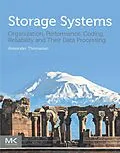Storage Systems: Organization, Performance, Coding, Reliability and Their Data Processing was motivated by the 1988 Redundant Array of Inexpensive/Independent Disks proposal to replace large form factor mainframe disks with an array of commodity disks. Disk loads are balanced by striping data into strips-with one strip per disk- and storage reliability is enhanced via replication or erasure coding, which at best dedicates k strips per stripe to tolerate k disk failures. Flash memories have resulted in a paradigm shift with Solid State Drives (SSDs) replacing Hard Disk Drives (HDDs) for high performance applications. RAID and Flash have resulted in the emergence of new storage companies, namely EMC, NetApp, SanDisk, and Purestorage, and a multibillion-dollar storage market. Key new conferences and publications are reviewed in this book.The goal of the book is to expose students, researchers, and IT professionals to the more important developments in storage systems, while covering the evolution of storage technologies, traditional and novel databases, and novel sources of data. We describe several prototypes: FAWN at CMU, RAMCloud at Stanford, and Lightstore at MIT; Oracle's Exadata, AWS' Aurora, Alibaba's PolarDB, Fungible Data Center; and author's paper designs for cloud storage, namely heterogeneous disk arrays and hierarchical RAID. - Surveys storage technologies and lists sources of data: measurements, text, audio, images, and video - Familiarizes with paradigms to improve performance: caching, prefetching, log-structured file systems, and merge-trees (LSMs) - Describes RAID organizations and analyzes their performance and reliability - Conserves storage via data compression, deduplication, compaction, and secures data via encryption - Specifies implications of storage technologies on performance and power consumption - Exemplifies database parallelism for big data, analytics, deep learning via multicore CPUs, GPUs, FPGAs, and ASICs, e.g., Google's Tensor Processing Units
Autorentext
Dr. Alexander Thomasian is founder and CEO of Thomasian & Associates consulting, in Pleasantville, NY, USA. He received his PhD in Computer Science from UCLA. Dr. Thomasian has held teaching and research positions at Case Western Reserve University, University of Southern California, Burroughs Corporation, IBM T. J. Watson Research Center, University of Connecticut, and New Jersey Institute of Technology. His assignment at IBM's Almaden Research Center led to his interest in storage systems. His later research in this area was funded by the U.S. National Science Foundation, Hitachi Global Storage Technologies, and AT&T. Dr. Thomasian spent a year at Shenzhen Institutes of Advanced Technology and was a Fulbright Fellow at the American University of Armenia. He is a Life Fellow of IEEE for fundamental contributions to the design and analysis of concurrency control methods and performance analysis of computer systems. He was an Editor of IEEE Transactions on Parallel and Distributed Systems and has been on the program committees of numerous international conferences.
Inhalt
1. Introduction 2. Storage Technologies and Their Data 3. Disk Drive Data Placement and Scheduling 4. Mirrored & Hybrid Arrays 5. Redundant Arrays of Independent Disks - RAID 6. Coding for Multiple Disk Failures 7. Saving Power in Disks, Flash Memories, and Servers 8. Database Parallelism, Big Data and Analytics, Deep Learning 9. Structured, Unstructured, and Diverse Databases 10. Heterogeneous Disk Arrays - HDAs 11. Hierarchical RAID - HRAID 12. Conclusions Appendix
